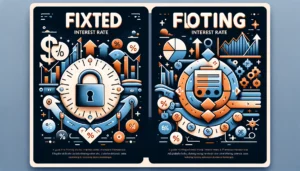A term loan is a specific type of loan that has a set duration for repayment and typically comes with a fixed or floating interest rate. Unlike revolving credit lines, where borrowers can draw, repay, and redraw again, a term loan provides a fixed amount of funds that the borrower must repay over a predetermined period.
The regular repayments, often monthly, include both the principal amount and the interest accrued. Depending on the duration, a term loan can be classified as a short-term loan or a long-term loan. Businesses frequently use term loans for capital expenditures or for significant investments in operations.
Definition of Term Loan
A term loan can be defined as a loan issued by a bank or financial institution for a specific amount with a specified repayment schedule and either a fixed or floating interest rate. The borrower receives the upfront lump sum from the lender and agrees to make regular payments until the loan’s maturity date. The principal objective of such loans is to finance long-term projects or capital-intensive investments that can help in business expansion or other significant expenditures.

Photo by Daniel Thomas on Unsplash
Overview of Term Loan
At its core, a term loan is straightforward. Once approved, the borrower receives the funds and is obligated to repay the loan over a set period, with interest. The interest rate can be fixed, where it remains constant throughout the loan tenure, or floating, where it varies based on market conditions or a reference rate.
The duration of the loan can vary widely, from short periods, like a few months in the case of short-term loans, to several years or even decades for long-term loans. Term loans are common in both personal and business finance scenarios. They offer borrowers the advantage of predictable payments, which can be crucial for budgeting and financial planning.
Types of Term Loans
Term loans can be broadly categorized based on their duration:
- Short-Term Loan: These are loans with a tenure typically less than a year. They cater to immediate or temporary financial needs, like managing cash flow gaps or financing short-term projects. Due to their shorter duration, they might have higher interest rates compared to long-term loans.
- Long-Term Loan: These loans have a tenure extending beyond a year and can go up to several years or decades. They’re generally used for significant investments, such as buying machinery, property, or business expansion. The extended duration usually allows for a lower monthly payment, but borrowers might end up paying more in total interest over the life of the loan.
Different financial institutions might offer various sub-categories or specialized types of term loans tailored to specific needs or industries. It’s essential for borrowers to understand the nuances of each type to choose the most suitable one for their requirements.
How Term Loans Work
Term loans operate on a straightforward principle. A borrower approaches a lending institution, such as a bank or a financial company, and requests a specific loan amount. Once approved, this amount is disbursed to the borrower, either as a lump sum in the case of a personal loan or in stages for certain types of business loans.
The borrower agrees to repay the loan amount, along with the interest, over a set period. The repayment schedule is typically monthly, though it can vary based on the loan agreement. Each repayment installment consists of a portion of the principal amount and the accrued interest.
Over time, a larger portion of the repayment goes towards the principal, reducing the outstanding loan amount. By the end of the term, the borrower would have repaid the entire loan amount and the interest.
Eligibility for Term Loans
Eligibility criteria for term loans often depend on the type of loan – personal or business. For a personal loan, lending institutions generally assess an individual’s credit score, employment status, income level, and existing liabilities. A higher credit score and stable income can increase the chances of loan approval and might even fetch a more favorable interest rate.
For a business loan, lenders evaluate the company’s financial health, operational history, profitability, and creditworthiness. They might also consider the purpose of the loan, whether it’s for expansion, purchasing equipment, or other business needs. A strong business plan and financial projections can bolster the chances of securing a business loan.
Attributes of Term Loans
Several defining attributes set term loans apart:
- Fixed Tenure: Term loans come with a predetermined duration, whether it’s a short-term loan spanning a few months or a long-term loan lasting several years.
- Interest Rates: The interest rate can be fixed, where it remains unchanged throughout the loan tenure, or variable, where it can fluctuate based on market conditions or benchmark rates.
- Repayment Schedule: Borrowers commit to a regular repayment schedule, typically monthly, which includes both the principal and the interest components.
- Loan Amount: The loan amount is decided at the onset, and once disbursed, the borrower cannot typically request additional funds as they would with a revolving credit line.
- Purpose: While personal loans are often unsecured and can be used for any purpose, business loans might come with stipulations on how the funds should be utilized.
Understanding these attributes is crucial for borrowers to manage their finances effectively and ensure timely repayment.
Different Types of Term Loans
Term loans come in various forms, each tailored to suit the specific needs of borrowers. These loans can be distinguished based on their duration, purpose, or the borrower’s profile. While the fundamental premise remains the same – borrowing a fixed amount and repaying it with interest over a set period – the terms and conditions can differ significantly.
Whether a borrower is an individual seeking personal financing or a small business owner looking for working capital, there’s likely a term loan designed to address their unique requirements. Understanding the distinctions between these loans is crucial for making informed borrowing decisions.
Long-Term Loans
Long-term loans are typically characterized by their extended repayment durations, which can range from a few years to several decades. These loans are often used for significant investments like purchasing property or machinery.
Due to their lengthy tenures, they usually come with lower monthly installments. However, the borrower might end up paying more in total interest over the loan’s life. Collateral is often required, and the eligibility criteria can be stringent, with lenders meticulously assessing the borrower’s creditworthiness and financial stability.
Short-Term Loans
Short-term loans are designed for immediate financial needs and have a repayment tenure of typically a year or less. They’re ideal for addressing temporary cash flow gaps or urgent expenses. For instance, a small business might take a short-term loan to boost its working capital during a slow season.
These loans often have higher interest rates compared to their long-term counterparts, reflecting the shorter lending period and potentially higher risk for the lender. The eligibility requirements might be less rigorous, but borrowers should be cautious and ensure they can repay within the stipulated timeframe.
Business Loans
Business loans cater specifically to the financial needs of enterprises, whether startups or established entities. They can be used for a myriad of purposes, from expanding operations and hiring staff to purchasing inventory.
Depending on the loan amount and the small business’s profile, the lender might require collateral as a security measure. Eligibility often hinges on the company’s financial health, operational history, and future projections. Lenders also consider the business plan and how the loan will contribute to the company’s growth.
Intermediate-Term Loans
Straddling the space between short-term and long-term loans, intermediate-term loans typically have tenures ranging from one to three years. They’re often used for purposes like renovating facilities, buying equipment, or launching marketing campaigns.
The borrower receives a lump sum and repays it in regular installments over the loan’s duration. Eligibility might be based on the borrower’s credit score, business performance, and the viability of the project for which the loan is sought. Given their mid-range tenure, the interest rates and collateral requirements can vary based on the lender’s assessment of risk.
Calculating Term Loan
Understanding how a term loan is calculated is vital for any potential borrower. This calculation offers clarity on how much needs to be repaid, helping in effective financial planning and ensuring consistent cash flow. The primary components factored into a term loan calculation are the principal amount (the sum borrowed), the interest rate (which can be fixed or floating), and the loan’s duration.
Using these parameters, one can determine the monthly installment, often referred to as the Equated Monthly Instalment (EMI), which the borrower will have to repay. Various online tools and calculators are available to simplify this calculation, providing borrowers with a clear picture of their loan repayment schedule.
EMI Calculation
The EMI is a fixed payment amount made by the borrower to the lender at a specified date each month. The EMI includes both the principal and the interest components. To calculate the EMI for a term loan, lenders typically use a standard formula that considers the principal loan amount, the interest rate, and the number of installments.
If the loan has a floating interest rate, the EMI might vary based on market conditions. Using an EMI calculator, borrowers can input these variables and receive a detailed breakdown of their monthly obligations, helping them manage their finances more effectively.
Example of a Term Loan Calculation
Let’s consider a hypothetical scenario: A borrower takes out a term loan of $10,000 with a fixed interest rate of 5% per annum, intending to repay it over 2 years (24 months). Using an EMI calculator, the borrower inputs these details. The calculator processes this information to determine that the monthly EMI would be approximately $438.71.
Over the 24-month period, this would amount to a total repayment of $10,528.96, of which $528.96 represents the interest. Such a breakdown not only helps the borrower understand the total interest outflow but also assists in making informed decisions, ensuring a consistent cash flow and timely repayments.
Interest Rates and Term Loans
Interest rates play a pivotal role in term loans, influencing the total cost of borrowing and the repayment schedule. Essentially, the interest rate is the cost paid for borrowing money, expressed as a percentage of the loan amount. For term loans, interest rates can be either fixed or floating.
A fixed interest rate remains constant throughout the loan’s duration, offering predictability in monthly payments. In contrast, a floating interest rate can fluctuate based on market conditions or a reference benchmark, leading to variations in the repayment amounts. The choice between fixed or floating rates often depends on the borrower’s preference, risk appetite, and the expected future movement of interest rates.
Factors Affecting Interest Rates
Several factors can influence the interest rates on term loans. One primary determinant is the monetary policy of central banks, which sets the base rate for lending. Additionally, individual lenders consider their operational costs, profit margins, and competitive positioning when setting rates.
The nature of the loan, whether it’s short-term or long-term, also affects the rate. Generally, longer-term loans carry higher rates due to the extended risk exposure. Lastly, the borrower’s creditworthiness plays a crucial role. Those with higher credit scores and a consistent repayment history may secure loans at more favorable rates, while those deemed riskier might face higher rates.
Eligibility for Term Loan Interest Rates
Eligibility for specific term loan interest rates hinges on various criteria. Lenders assess the borrower’s credit score, financial stability, and past repayment history. A strong credit score often translates to a lower interest rate, as the borrower is perceived as less risky.
The loan amount and duration can also influence the rate; larger loans or longer durations might command different rates. Additionally, the type of interest, whether fixed or floating, plays a part. With floating interest, the rate is tied to a benchmark and can vary, while a fixed rate remains constant. Before committing to a loan, borrowers should understand the factors influencing the interest rate, ensuring they secure the most favorable terms aligned with their financial situation.
How to Avail a Term Loan
Availing a term loan requires a structured approach, beginning with understanding the term loan definition. By definition, a term loan is a loan that has a set tenure for repayment, typically with fixed or variable interest rates.
Once a borrower is clear about the type of loan they require, be it a short, intermediate-term loan, or long-term loan, they should identify potential lenders. This could be banks, financial institutions, or online lending platforms. It’s essential to research and compare term loan interest rates, repayment terms, and other conditions across various lenders.
After zeroing in on a suitable lender, the borrower can initiate the application process. Many lenders today offer both offline and online modes of application, enhancing convenience. Throughout the process, it’s crucial to understand how term loans work, ensuring a smooth borrowing experience.
Application Process
The application process for a term loan typically begins with the borrower filling out an application form, either online or at a physical branch. This form captures essential details like the desired loan amount, tenure, and purpose. Alongside the application, the borrower might need to provide various documents to support their eligibility.
Once submitted, the lender evaluates the application, considering the borrower’s creditworthiness, financial stability, and the loan’s feasibility. After this assessment, the lender either approves or rejects the loan. If approved, the loan amount is disbursed to the borrower, either directly to their bank account or through a cheque.
Documentation Required
The documentation required for a term loan can vary based on the lender and the nature of the loan. However, standard documents often include:
- Identity proof (such as a passport, driver’s license, or national ID)
- Address proof (like utility bills or rental agreements)
- Proof of income (salary slips, tax returns, or profit and loss statements for business owners)
- Employment or business continuity proof
- Credit report or credit score details
- Any other documents specifying collateral, especially if the term loan is a secured type of loan.
It’s essential to ensure all documents are up-to-date and authentic to facilitate a smooth approval process.
Term Loan EMI Calculator
A Term Loan EMI (Equated Monthly Installment) Calculator is a digital tool designed to help borrowers understand their monthly repayment amount for a term loan. Whether it’s a secured loan for a property or an unsecured loan for business expansion, knowing the EMI can significantly aid in financial planning.
By inputting details like the principal loan amount, tenure, and interest rate into the calculator, borrowers can get an estimated monthly repayment amount. For example, a term loan may have varying EMIs based on whether it’s a fixed-rate loan or a floating interest rate loan. Such calculators often provide a breakdown, showing the division between the principal and interest components of each EMI.
Using an EMI Calculator
To use an EMI calculator effectively, start by entering the principal amount, which is the total sum borrowed. Next, input the interest rate. Remember, loans come with either fixed or variable interest rates, and this can influence the EMI.
Then, specify the loan’s tenure, which could range from a few months to several years. Once these details are entered, the calculator processes the information and displays the estimated EMI. For a business owner, understanding this EMI can be crucial to gauge how the loan generally fits into the company’s financial landscape and monthly expenses.
Benefits of Using an EMI Calculator
There are several benefits to using an EMI calculator before availing a term loan. Firstly, it offers clarity. By providing an approximate monthly repayment figure, borrowers can assess their ability to manage the EMI alongside other financial commitments.
This foresight can prevent potential defaults or financial strain in the future. Additionally, by tweaking the inputs like loan amount or tenure, borrowers can see how changes affect the EMI, aiding in making informed borrowing decisions. An EMI calculator also breaks down the repayment schedule, illustrating how much of the EMI goes towards the principal and how much caters to the interest.
This transparency can be enlightening, especially for those keen on understanding the intricacies of their loan. Lastly, using an EMI calculator can save time and effort, offering quick insights without the need for manual calculations or consultations.
Eligibility Criteria for Term Loans
Term loan eligibility plays a pivotal role in determining whether a borrower can avail of a specific loan and the terms associated with it, such as the rate of interest. Most lenders have a set of predetermined criteria that applicants must meet to qualify for a loan.
These criteria are designed to assess the borrower’s capability to repay the loan, ensuring that the lender’s risk is minimized. Factors such as the borrower’s age, employment status, financial health, and credit history are often taken into account.
Additionally, the purpose of the loan, whether it’s for personal use or business expansion, can influence the eligibility parameters. Before applying, it’s advisable for borrowers to familiarize themselves with the lender’s eligibility criteria to streamline the application process and increase the chances of approval.
Income and Credit Score Requirements
A borrower’s income and credit score are primary determinants in the term loan eligibility process. Regular and stable income signifies the borrower’s ability to manage the monthly repayments. Lenders might request salary slips, tax returns, or business profit and loss statements to verify this income.
On the other hand, a credit score reflects the borrower’s creditworthiness, providing insights into their past borrowing and repayment behaviors. A higher credit score can not only enhance the chances of loan approval but might also fetch a more favorable rate of interest.
Many individuals use tools like the EMI calculator to assess how different interest rates can impact their monthly outgo, emphasizing the significance of a good credit score.
Collateral and Security
When a term loan comes with the stipulation of collateral, it means the loan requires the borrower to pledge an asset as security. This collateral acts as a safeguard for the lender, ensuring they have a means to recoup their funds should the borrower default on the loan.
Collateral can range from property and machinery to stocks and other valuable assets. Secured loans, which require collateral, often come with lower interest rates compared to unsecured loans, reflecting the reduced risk for the lender.
Before availing of a secured term loan, borrowers should be fully aware of the terms associated with the collateral, including the conditions under which the lender might liquidate the asset. Evaluating these terms can help in making an informed borrowing decision.
Introducing School of Money
Looking to monetize your passion and skills? Dive into the School of Money – your one-stop platform for mastering the art of earning.
Whether you’re an aspiring entrepreneur, trader, or just someone keen on financial growth, our comprehensive insights on personal development, finance, and leadership are tailored for you.
Embark on a transformative journey to financial literacy and independence with School of Money and unlock your true earning potential!









